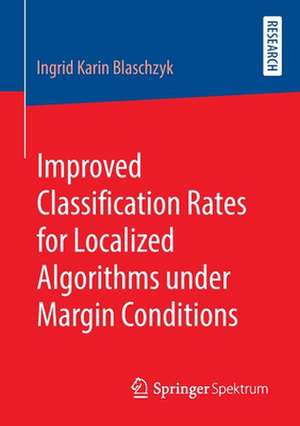Improved Classification Rates for Localized Algorithms under Margin Conditions
Autor Ingrid Karin Blaschzyken Limba Engleză Paperback – 19 mar 2020
Preț: 378.12 lei
Nou
Puncte Express: 567
Preț estimativ în valută:
72.38€ • 78.64$ • 60.84£
72.38€ • 78.64$ • 60.84£
Carte tipărită la comandă
Livrare economică 21 aprilie-05 mai
Preluare comenzi: 021 569.72.76
Specificații
ISBN-13: 9783658295905
ISBN-10: 3658295902
Pagini: 126
Ilustrații: XV, 126 p. 5 illus. in color.
Dimensiuni: 148 x 210 mm
Greutate: 0.18 kg
Ediția:1st ed. 2020
Editura: Springer Fachmedien Wiesbaden
Colecția Springer Spektrum
Locul publicării:Wiesbaden, Germany
ISBN-10: 3658295902
Pagini: 126
Ilustrații: XV, 126 p. 5 illus. in color.
Dimensiuni: 148 x 210 mm
Greutate: 0.18 kg
Ediția:1st ed. 2020
Editura: Springer Fachmedien Wiesbaden
Colecția Springer Spektrum
Locul publicării:Wiesbaden, Germany
Cuprins
Introduction to Statistical Learning Theory.- Histogram Rule: Oracle Inequality and Learning Rates.- Localized SVMs: Oracle Inequalities and Learning Rates.
Notă biografică
Ingrid Karin Blaschzyk is a postdoctoral researcher in the Department of Mathematics at the University of Stuttgart, Germany.
Textul de pe ultima copertă
Support vector machines (SVMs) are one of the most successful algorithms on small and medium-sized data sets, but on large-scale data sets their training and predictions become computationally infeasible. The author considers a spatially defined data chunking method for large-scale learning problems, leading to so-called localized SVMs, and implements an in-depth mathematical analysis with theoretical guarantees, which in particular include classification rates. The statistical analysis relies on a new and simple partitioning based technique and takes well-known margin conditions into account that describe the behavior of the data-generating distribution. It turns out that the rates outperform known rates of several other learning algorithms under suitable sets of assumptions. From a practical point of view, the author shows that a common training and validation procedure achieves the theoretical rates adaptively, that is, without knowing the margin parameters in advance.Contents
Researchers, students, and practitioners in the fields of mathematics and computer sciences who focus on machine learning or statistical learning theory
The Author
Ingrid Karin Blaschzyk is a postdoctoral researcher in the Department of Mathematics at the University of Stuttgart, Germany.
- Introduction to Statistical Learning Theory
- Histogram Rule: Oracle Inequality and Learning Rates
- Localized SVMs: Oracle Inequalities and Learning Rates
Researchers, students, and practitioners in the fields of mathematics and computer sciences who focus on machine learning or statistical learning theory
The Author
Ingrid Karin Blaschzyk is a postdoctoral researcher in the Department of Mathematics at the University of Stuttgart, Germany.
Caracteristici
Study in the field of natural sciences Study in the field of statistical learning theory
